Credit Card Approval Prediction#
by FRIDHA MEGANTARA PUTRA#
import pandas as pd
import matplotlib.pyplot as plt
import pandas as pd
from datetime import datetime, timedelta
penejelasan dataset#
Kartu skor kredit adalah metode pengendalian risiko yang umum digunakan dalam industri keuangan. Metode ini menggunakan informasi pribadi dan data yang diajukan oleh pemohon kartu kredit untuk memprediksi kemungkinan gagal bayar di masa depan dan pinjaman kartu kredit. Bank dapat memutuskan apakah akan menerbitkan kartu kredit kepada pemohon. Skor kredit dapat mengkuantifikasi besarnya risiko secara objektif.
Feature name |
Explanation |
Remarks |
|---|---|---|
ID |
Client number |
|
CODE_GENDER |
Gender |
|
FLAG_OWN_CAR |
Is there a car |
|
FLAG_OWN_REALTY |
Is there a property |
|
CNT_CHILDREN |
Number of children |
|
AMT_INCOME_TOTAL |
Annual income |
|
NAME_INCOME_TYPE |
Income category |
|
NAME_EDUCATION_TYPE |
Education level |
|
NAME_FAMILY_STATUS |
Marital status |
|
NAME_HOUSING_TYPE |
Way of living |
|
DAYS_BIRTH |
Birthday |
Count backwards from current day (0), -1 means yesterday |
DAYS_EMPLOYED |
Start date of employment |
Count backwards from current day (0). If positive, it means the person is currently unemployed. |
FLAG_MOBIL |
Is there a mobile phone |
|
FLAG_WORK_PHONE |
Is there a work phone |
|
FLAG_PHONE |
Is there a phone |
|
FLAG_EMAIL |
Is there an email |
|
OCCUPATION_TYPE |
Occupation |
|
CNT_FAM_MEMBERS |
Family size |
Feature name |
Explanation |
Remarks |
|---|---|---|
ID |
Client number |
|
MONTHS_BALANCE |
Record month |
The month of the extracted data is the starting point, backwards, 0 is the current month, -1 is the previous month, and so on |
STATUS |
Status |
0: 1-29 days past due |
IMPORT DATASET#
# df1 = pd.read_csv('/kaggle/input/credit-card-approval-prediction/application_record.csv')
# print (df1['CODE_GENDER'].unique())
# print (df1['FLAG_OWN_CAR'].unique())
# print (df1['FLAG_OWN_REALTY'].unique())
# print (df1['CNT_CHILDREN'].unique())
# print (df1['NAME_INCOME_TYPE'].unique())
# print (df1['NAME_EDUCATION_TYPE'].unique())
# print (df1['NAME_FAMILY_STATUS'].unique())
# print (df1['NAME_HOUSING_TYPE'].unique())
# print (df1['OCCUPATION_TYPE'].unique())
# print (df['CNT_FAM_MEMBERS'].unique())
df1.dtypes
---------------------------------------------------------------------------
NameError Traceback (most recent call last)
Cell In[4], line 1
----> 1 df1.dtypes
NameError: name 'df1' is not defined
df1.head()
| ID | CODE_GENDER | FLAG_OWN_CAR | FLAG_OWN_REALTY | CNT_CHILDREN | AMT_INCOME_TOTAL | NAME_INCOME_TYPE | NAME_EDUCATION_TYPE | NAME_FAMILY_STATUS | NAME_HOUSING_TYPE | DAYS_BIRTH | DAYS_EMPLOYED | FLAG_MOBIL | FLAG_WORK_PHONE | FLAG_PHONE | FLAG_EMAIL | OCCUPATION_TYPE | CNT_FAM_MEMBERS | |
|---|---|---|---|---|---|---|---|---|---|---|---|---|---|---|---|---|---|---|
| 0 | 5008804 | M | Y | Y | 0 | 427500.0 | Working | Higher education | Civil marriage | Rented apartment | -12005 | -4542 | 1 | 1 | 0 | 0 | NaN | 2.0 |
| 1 | 5008805 | M | Y | Y | 0 | 427500.0 | Working | Higher education | Civil marriage | Rented apartment | -12005 | -4542 | 1 | 1 | 0 | 0 | NaN | 2.0 |
| 2 | 5008806 | M | Y | Y | 0 | 112500.0 | Working | Secondary / secondary special | Married | House / apartment | -21474 | -1134 | 1 | 0 | 0 | 0 | Security staff | 2.0 |
| 3 | 5008808 | F | N | Y | 0 | 270000.0 | Commercial associate | Secondary / secondary special | Single / not married | House / apartment | -19110 | -3051 | 1 | 0 | 1 | 1 | Sales staff | 1.0 |
| 4 | 5008809 | F | N | Y | 0 | 270000.0 | Commercial associate | Secondary / secondary special | Single / not married | House / apartment | -19110 | -3051 | 1 | 0 | 1 | 1 | Sales staff | 1.0 |
Pra Pemrosesan#
encode data kategorikal menjadi binary dan ubah tanggal menjadi tanggal asli dari sekarag#
kolom yang memiliki nilai kategorikal akan di encode menjadi binary dan mengubah tanggal menjadi tanggal asli
import pandas as pd
# Definisikan kolom-kolom yang perlu diubah
columns_to_encode = [
'CODE_GENDER',
'FLAG_OWN_CAR',
'FLAG_OWN_REALTY',
'NAME_INCOME_TYPE',
'NAME_EDUCATION_TYPE',
'NAME_FAMILY_STATUS',
'NAME_HOUSING_TYPE',
'OCCUPATION_TYPE'
]
# Lakukan one-hot encoding untuk setiap kolom
for column in columns_to_encode:
df1 = pd.get_dummies(df1, columns=[column], prefix=column.replace('_', ' '))
# Ubah nilai False menjadi 0 dan True menjadi 1
for column in df1.columns:
if df1[column].dtype == bool:
df1[column] = df1[column].astype(int)
# columns_to_encode = [
# 'CODE_GENDER',
# 'FLAG_OWN_CAR',
# 'FLAG_OWN_REALTY',
# 'NAME_INCOME_TYPE',
# 'NAME_EDUCATION_TYPE',
# 'NAME_FAMILY_STATUS',
# 'NAME_HOUSING_TYPE',
# 'OCCUPATION_TYPE'
# ]
# for column in columns_to_encode:
# df1 = pd.get_dummies(df1, columns=[column], prefix=column.replace('_', ' '))
# ------------------------------------------------------------------------------------------------
# Tanggal hari ini
today = datetime.today()
def days_birth_to_date(days_birth):
birth_date = datetime.today() + timedelta(days=days_birth)
return birth_date.strftime('%d-%m-%Y')
# Ubah DAYS_BIRTH menjadi usia dalam tahun
df1['AGE'] = abs(df1['DAYS_BIRTH']) / 365
# Bulatkan usia ke bilangan bulat terdekat
df1['AGE'] = round(df1['AGE'])
# Ubah DAYS_BIRTH menjadi usia dalam tahun
df1['EMPLOYED'] = abs(df1['DAYS_EMPLOYED']) / 365
# Bulatkan usia ke bilangan bulat terdekat
df1['DAYS_EMPLOYED'] = round(df1['DAYS_EMPLOYED'])
df1.head()
| ID | CNT_CHILDREN | AMT_INCOME_TOTAL | DAYS_BIRTH | DAYS_EMPLOYED | FLAG_MOBIL | FLAG_WORK_PHONE | FLAG_PHONE | FLAG_EMAIL | CNT_FAM_MEMBERS | ... | OCCUPATION TYPE_Managers | OCCUPATION TYPE_Medicine staff | OCCUPATION TYPE_Private service staff | OCCUPATION TYPE_Realty agents | OCCUPATION TYPE_Sales staff | OCCUPATION TYPE_Secretaries | OCCUPATION TYPE_Security staff | OCCUPATION TYPE_Waiters/barmen staff | AGE | EMPLOYED | |
|---|---|---|---|---|---|---|---|---|---|---|---|---|---|---|---|---|---|---|---|---|---|
| 0 | 5008804 | 0 | 427500.0 | -12005 | -4542 | 1 | 1 | 0 | 0 | 2.0 | ... | 0 | 0 | 0 | 0 | 0 | 0 | 0 | 0 | 33.0 | 12.443836 |
| 1 | 5008805 | 0 | 427500.0 | -12005 | -4542 | 1 | 1 | 0 | 0 | 2.0 | ... | 0 | 0 | 0 | 0 | 0 | 0 | 0 | 0 | 33.0 | 12.443836 |
| 2 | 5008806 | 0 | 112500.0 | -21474 | -1134 | 1 | 0 | 0 | 0 | 2.0 | ... | 0 | 0 | 0 | 0 | 0 | 0 | 1 | 0 | 59.0 | 3.106849 |
| 3 | 5008808 | 0 | 270000.0 | -19110 | -3051 | 1 | 0 | 1 | 1 | 1.0 | ... | 0 | 0 | 0 | 0 | 1 | 0 | 0 | 0 | 52.0 | 8.358904 |
| 4 | 5008809 | 0 | 270000.0 | -19110 | -3051 | 1 | 0 | 1 | 1 | 1.0 | ... | 0 | 0 | 0 | 0 | 1 | 0 | 0 | 0 | 52.0 | 8.358904 |
5 rows × 57 columns
# df2= pd.read_csv('/kaggle/input/credit-card-approval-prediction/credit_record.csv')
df2.head()
| ID | MONTHS_BALANCE | STATUS | |
|---|---|---|---|
| 0 | 5001711 | 0 | X |
| 1 | 5001711 | -1 | 0 |
| 2 | 5001711 | -2 | 0 |
| 3 | 5001711 | -3 | 0 |
| 4 | 5001712 | 0 | C |
#
Mengubah Nilai pada data 2#
Nilai 6 mewakili ‘X’ dan 7 mewakili ‘C’, dianggap sebagai ekstensi dari 0-5.#
hal ini dilakukan agar tidak ada huruf
# One-hot encoding
df2_encoded = pd.get_dummies(df2, columns=['STATUS'], prefix='STATUS')
# atau Binary encoding
df2['STATUS'] = df2['STATUS'].replace({'X': 6, 'C': 7})
# Nilai di atas 5 mewakili 'X' dan 'C', dianggap sebagai ekstensi dari 0-5.
df2_encoded = df2
print(df2_encoded)
ID MONTHS_BALANCE STATUS
0 5001711 0 6
1 5001711 -1 0
2 5001711 -2 0
3 5001711 -3 0
4 5001712 0 7
... ... ... ...
1048570 5150487 -25 7
1048571 5150487 -26 7
1048572 5150487 -27 7
1048573 5150487 -28 7
1048574 5150487 -29 7
[1048575 rows x 3 columns]
melakukan merge#
df1 dan df2 akan di merge#
df1 dan df2 akan di merge dengan inner berdasarkan ID
df = pd.merge(df1, df2, on='ID', how='inner')
df.head()
| ID | CNT_CHILDREN | AMT_INCOME_TOTAL | DAYS_BIRTH | DAYS_EMPLOYED | FLAG_MOBIL | FLAG_WORK_PHONE | FLAG_PHONE | FLAG_EMAIL | CNT_FAM_MEMBERS | ... | OCCUPATION TYPE_Private service staff | OCCUPATION TYPE_Realty agents | OCCUPATION TYPE_Sales staff | OCCUPATION TYPE_Secretaries | OCCUPATION TYPE_Security staff | OCCUPATION TYPE_Waiters/barmen staff | AGE | EMPLOYED | MONTHS_BALANCE | STATUS | |
|---|---|---|---|---|---|---|---|---|---|---|---|---|---|---|---|---|---|---|---|---|---|
| 0 | 5008804 | 0 | 427500.0 | -12005 | -4542 | 1 | 1 | 0 | 0 | 2.0 | ... | 0 | 0 | 0 | 0 | 0 | 0 | 33.0 | 12.443836 | 0 | 7 |
| 1 | 5008804 | 0 | 427500.0 | -12005 | -4542 | 1 | 1 | 0 | 0 | 2.0 | ... | 0 | 0 | 0 | 0 | 0 | 0 | 33.0 | 12.443836 | -1 | 7 |
| 2 | 5008804 | 0 | 427500.0 | -12005 | -4542 | 1 | 1 | 0 | 0 | 2.0 | ... | 0 | 0 | 0 | 0 | 0 | 0 | 33.0 | 12.443836 | -2 | 7 |
| 3 | 5008804 | 0 | 427500.0 | -12005 | -4542 | 1 | 1 | 0 | 0 | 2.0 | ... | 0 | 0 | 0 | 0 | 0 | 0 | 33.0 | 12.443836 | -3 | 7 |
| 4 | 5008804 | 0 | 427500.0 | -12005 | -4542 | 1 | 1 | 0 | 0 | 2.0 | ... | 0 | 0 | 0 | 0 | 0 | 0 | 33.0 | 12.443836 | -4 | 7 |
5 rows × 59 columns
df.tail
<bound method NDFrame.tail of ID CNT_CHILDREN AMT_INCOME_TOTAL DAYS_BIRTH DAYS_EMPLOYED \
0 5008804 0 427500.0 -12005 -4542
1 5008804 0 427500.0 -12005 -4542
2 5008804 0 427500.0 -12005 -4542
3 5008804 0 427500.0 -12005 -4542
4 5008804 0 427500.0 -12005 -4542
... ... ... ... ... ...
777710 5150337 0 112500.0 -9188 -1193
777711 5150337 0 112500.0 -9188 -1193
777712 5150337 0 112500.0 -9188 -1193
777713 5150337 0 112500.0 -9188 -1193
777714 5150337 0 112500.0 -9188 -1193
FLAG_MOBIL FLAG_WORK_PHONE FLAG_PHONE FLAG_EMAIL CNT_FAM_MEMBERS \
0 1 1 0 0 2.0
1 1 1 0 0 2.0
2 1 1 0 0 2.0
3 1 1 0 0 2.0
4 1 1 0 0 2.0
... ... ... ... ... ...
777710 1 0 0 0 1.0
777711 1 0 0 0 1.0
777712 1 0 0 0 1.0
777713 1 0 0 0 1.0
777714 1 0 0 0 1.0
... OCCUPATION TYPE_Private service staff \
0 ... 0
1 ... 0
2 ... 0
3 ... 0
4 ... 0
... ... ...
777710 ... 0
777711 ... 0
777712 ... 0
777713 ... 0
777714 ... 0
OCCUPATION TYPE_Realty agents OCCUPATION TYPE_Sales staff \
0 0 0
1 0 0
2 0 0
3 0 0
4 0 0
... ... ...
777710 0 0
777711 0 0
777712 0 0
777713 0 0
777714 0 0
OCCUPATION TYPE_Secretaries OCCUPATION TYPE_Security staff \
0 0 0
1 0 0
2 0 0
3 0 0
4 0 0
... ... ...
777710 0 0
777711 0 0
777712 0 0
777713 0 0
777714 0 0
OCCUPATION TYPE_Waiters/barmen staff AGE EMPLOYED MONTHS_BALANCE \
0 0 33.0 12.443836 0
1 0 33.0 12.443836 -1
2 0 33.0 12.443836 -2
3 0 33.0 12.443836 -3
4 0 33.0 12.443836 -4
... ... ... ... ...
777710 0 25.0 3.268493 -9
777711 0 25.0 3.268493 -10
777712 0 25.0 3.268493 -11
777713 0 25.0 3.268493 -12
777714 0 25.0 3.268493 -13
STATUS
0 7
1 7
2 7
3 7
4 7
... ...
777710 0
777711 2
777712 1
777713 0
777714 0
[777715 rows x 59 columns]>
Drop Kolom#
buang kolom yang tidak digunakan#
kolom ini di buang karena saat one-hot encoding akan membuat kolom baru yang berupa bunary jadi kolom lama sudah tidak di gunakan lagi karna sudah tergantikan
df.drop(columns=['ID', 'AMT_INCOME_TOTAL', 'DAYS_BIRTH', 'DAYS_EMPLOYED'], inplace=True)
df
| CNT_CHILDREN | FLAG_MOBIL | FLAG_WORK_PHONE | FLAG_PHONE | FLAG_EMAIL | CNT_FAM_MEMBERS | CODE GENDER_F | CODE GENDER_M | FLAG OWN CAR_N | FLAG OWN CAR_Y | ... | OCCUPATION TYPE_Private service staff | OCCUPATION TYPE_Realty agents | OCCUPATION TYPE_Sales staff | OCCUPATION TYPE_Secretaries | OCCUPATION TYPE_Security staff | OCCUPATION TYPE_Waiters/barmen staff | AGE | EMPLOYED | MONTHS_BALANCE | STATUS | |
|---|---|---|---|---|---|---|---|---|---|---|---|---|---|---|---|---|---|---|---|---|---|
| 0 | 0 | 1 | 1 | 0 | 0 | 2.0 | 0 | 1 | 0 | 1 | ... | 0 | 0 | 0 | 0 | 0 | 0 | 33.0 | 12.443836 | 0 | 7 |
| 1 | 0 | 1 | 1 | 0 | 0 | 2.0 | 0 | 1 | 0 | 1 | ... | 0 | 0 | 0 | 0 | 0 | 0 | 33.0 | 12.443836 | -1 | 7 |
| 2 | 0 | 1 | 1 | 0 | 0 | 2.0 | 0 | 1 | 0 | 1 | ... | 0 | 0 | 0 | 0 | 0 | 0 | 33.0 | 12.443836 | -2 | 7 |
| 3 | 0 | 1 | 1 | 0 | 0 | 2.0 | 0 | 1 | 0 | 1 | ... | 0 | 0 | 0 | 0 | 0 | 0 | 33.0 | 12.443836 | -3 | 7 |
| 4 | 0 | 1 | 1 | 0 | 0 | 2.0 | 0 | 1 | 0 | 1 | ... | 0 | 0 | 0 | 0 | 0 | 0 | 33.0 | 12.443836 | -4 | 7 |
| ... | ... | ... | ... | ... | ... | ... | ... | ... | ... | ... | ... | ... | ... | ... | ... | ... | ... | ... | ... | ... | ... |
| 777710 | 0 | 1 | 0 | 0 | 0 | 1.0 | 0 | 1 | 1 | 0 | ... | 0 | 0 | 0 | 0 | 0 | 0 | 25.0 | 3.268493 | -9 | 0 |
| 777711 | 0 | 1 | 0 | 0 | 0 | 1.0 | 0 | 1 | 1 | 0 | ... | 0 | 0 | 0 | 0 | 0 | 0 | 25.0 | 3.268493 | -10 | 2 |
| 777712 | 0 | 1 | 0 | 0 | 0 | 1.0 | 0 | 1 | 1 | 0 | ... | 0 | 0 | 0 | 0 | 0 | 0 | 25.0 | 3.268493 | -11 | 1 |
| 777713 | 0 | 1 | 0 | 0 | 0 | 1.0 | 0 | 1 | 1 | 0 | ... | 0 | 0 | 0 | 0 | 0 | 0 | 25.0 | 3.268493 | -12 | 0 |
| 777714 | 0 | 1 | 0 | 0 | 0 | 1.0 | 0 | 1 | 1 | 0 | ... | 0 | 0 | 0 | 0 | 0 | 0 | 25.0 | 3.268493 | -13 | 0 |
777715 rows × 55 columns
nomalisai#
melakukan normalisasi menggunakan MinMax scaler#
normalissasi berguna untuk mengubah nilai menjadi antara 0-1 agar tidak terjadi perbedaan data yang signifikan antar input yang lain
from sklearn.preprocessing import MinMaxScaler
# Inisialisasi MinMaxScaler
scaler = MinMaxScaler()
# Ambil kolom yang ingin dinormalisasi (tidak termasuk kolom "STATUS")
columns_to_normalize = df.columns.difference(['STATUS'])
# Lakukan normalisasi pada kolom yang dipilih
df_normalized = df.copy() # Membuat salinan DataFrame untuk hasil normalisasi
df_normalized[columns_to_normalize] = scaler.fit_transform(df_normalized[columns_to_normalize])
simpan data normalisasi
df_normalized.to_csv('normal.csv')
df_normalized.dtypes
CNT_CHILDREN float64
FLAG_MOBIL float64
FLAG_WORK_PHONE float64
FLAG_PHONE float64
FLAG_EMAIL float64
CNT_FAM_MEMBERS float64
CODE GENDER_F float64
CODE GENDER_M float64
FLAG OWN CAR_N float64
FLAG OWN CAR_Y float64
FLAG OWN REALTY_N float64
FLAG OWN REALTY_Y float64
NAME INCOME TYPE_Commercial associate float64
NAME INCOME TYPE_Pensioner float64
NAME INCOME TYPE_State servant float64
NAME INCOME TYPE_Student float64
NAME INCOME TYPE_Working float64
NAME EDUCATION TYPE_Academic degree float64
NAME EDUCATION TYPE_Higher education float64
NAME EDUCATION TYPE_Incomplete higher float64
NAME EDUCATION TYPE_Lower secondary float64
NAME EDUCATION TYPE_Secondary / secondary special float64
NAME FAMILY STATUS_Civil marriage float64
NAME FAMILY STATUS_Married float64
NAME FAMILY STATUS_Separated float64
NAME FAMILY STATUS_Single / not married float64
NAME FAMILY STATUS_Widow float64
NAME HOUSING TYPE_Co-op apartment float64
NAME HOUSING TYPE_House / apartment float64
NAME HOUSING TYPE_Municipal apartment float64
NAME HOUSING TYPE_Office apartment float64
NAME HOUSING TYPE_Rented apartment float64
NAME HOUSING TYPE_With parents float64
OCCUPATION TYPE_Accountants float64
OCCUPATION TYPE_Cleaning staff float64
OCCUPATION TYPE_Cooking staff float64
OCCUPATION TYPE_Core staff float64
OCCUPATION TYPE_Drivers float64
OCCUPATION TYPE_HR staff float64
OCCUPATION TYPE_High skill tech staff float64
OCCUPATION TYPE_IT staff float64
OCCUPATION TYPE_Laborers float64
OCCUPATION TYPE_Low-skill Laborers float64
OCCUPATION TYPE_Managers float64
OCCUPATION TYPE_Medicine staff float64
OCCUPATION TYPE_Private service staff float64
OCCUPATION TYPE_Realty agents float64
OCCUPATION TYPE_Sales staff float64
OCCUPATION TYPE_Secretaries float64
OCCUPATION TYPE_Security staff float64
OCCUPATION TYPE_Waiters/barmen staff float64
AGE float64
EMPLOYED float64
MONTHS_BALANCE float64
STATUS object
dtype: object
membagi data menjadi train dan tes#
data akan di bagi menjadi test dan train dengan distribusi data train 80% dan test 20%
# data = pd.read_csv('/kaggle/working/normal.csv')
from sklearn.model_selection import train_test_split
# Pisahkan fitur (X) dan label (Y)
X = data.drop(columns=['STATUS']) # Ambil semua kolom kecuali 'STATUS'
Y = data['STATUS'] # Ambil kolom 'STATUS' sebagai label
# Bagi data menjadi data pelatihan dan data uji
# Gunakan parameter stratify untuk memastikan pembagian yang seimbang berdasarkan label Y
X_train, X_test, Y_train, Y_test = train_test_split(X, Y, test_size=0.2, random_state=42, stratify=Y)
Modeling#
Memnamgun model dengan Multi Layer Perceptron#
from sklearn.neural_network import MLPClassifier
from sklearn.metrics import accuracy_score
# Inisialisasi model MLP
mlp_model = MLPClassifier(hidden_layer_sizes=(100, 50), max_iter=50, random_state=42)
# Latih model pada data pelatihan
mlp_model.fit(X_train, Y_train)
# Lakukan prediksi pada data uji
Y_pred = mlp_model.predict(X_test)
# Evaluasi performa model
accuracy = accuracy_score(Y_test, Y_pred)
print("Accuracy:", accuracy)
Accuracy: 0.42372205756607495
Membangun model dengan KNN#
from sklearn.neighbors import KNeighborsClassifier
# Inisialisasi model KNN
knn_model = KNeighborsClassifier(n_neighbors=5)
# Latih model pada data pelatihan
knn_model.fit(X_train, Y_train)
# Lakukan prediksi pada data uji
Y_pred_knn = knn_model.predict(X_test)
# Evaluasi performa model
accuracy_knn = accuracy_score(Y_test, Y_pred_knn)
print("Accuracy KNN:", accuracy_knn)
Accuracy KNN: 0.8835434574362073
Membangun model dengan gaussian naive bayes#
from sklearn.naive_bayes import GaussianNB
# Inisialisasi model Naive Bayes
nb_model = GaussianNB()
# Latih model pada data pelatihan
nb_model.fit(X_train, Y_train)
# Lakukan prediksi pada data uji
Y_pred_nb = nb_model.predict(X_test)
# Evaluasi performa model
accuracy_nb = accuracy_score(Y_test, Y_pred_nb)
print("Accuracy Naive Bayes:", accuracy_nb)
Accuracy Naive Bayes: 0.42372205756607495
Membangn=un Model dengan Random Forest Classifier#
from sklearn.ensemble import RandomForestClassifier
from sklearn.metrics import accuracy_score
# Inisialisasi model Random Forest
rf_model = RandomForestClassifier(n_estimators=100, random_state=42)
# Latih model pada data pelatihan
rf_model.fit(X_train, Y_train)
# Lakukan prediksi pada data uji
Y_pred_rf = rf_model.predict(X_test)
# Evaluasi performa model
accuracy_rf = accuracy_score(Y_test, Y_pred_rf)
print("Accuracy Random Forest:", accuracy_rf)
Accuracy Random Forest: 0.8743562873289058
Evaluasi Matrix Setiap Model#
Confusion Matrix for MLP Classifier#
import matplotlib.pyplot as plt
from sklearn.metrics import confusion_matrix, ConfusionMatrixDisplay
# Menghitung confusion matrix
cm = confusion_matrix(Y_test, Y_pred)
# Menampilkan confusion matrix
disp = ConfusionMatrixDisplay(confusion_matrix=cm)
disp.plot(cmap=plt.cm.Blues)
plt.title("Confusion Matrix for MLP Classifier")
plt.show()
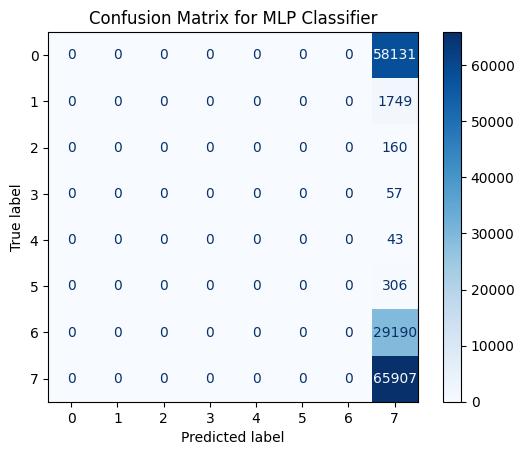
Confusion Matrix for KNN Classifier#
# Menghitung confusion matrix
cm_knn = confusion_matrix(Y_test, Y_pred_knn)
# Menampilkan confusion matrix
disp_knn = ConfusionMatrixDisplay(confusion_matrix=cm_knn)
disp_knn.plot(cmap=plt.cm.BuGn)
plt.title("Confusion Matrix for KNN Classifier")
plt.show()
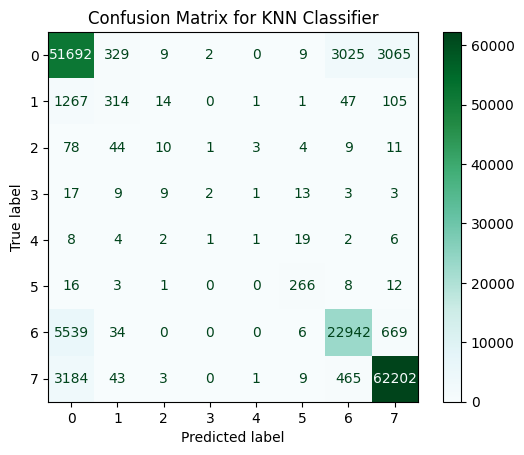
Confusion Matrix for Naive Bayes Classifier#
# Menghitung confusion matrix
cm_nb = confusion_matrix(Y_test, Y_pred_nb)
# Menampilkan confusion matrix
disp_nb = ConfusionMatrixDisplay(confusion_matrix=cm_nb)
disp_nb.plot(cmap=plt.cm.PuBu)
plt.title("Confusion Matrix for Naive Bayes Classifier")
plt.show()
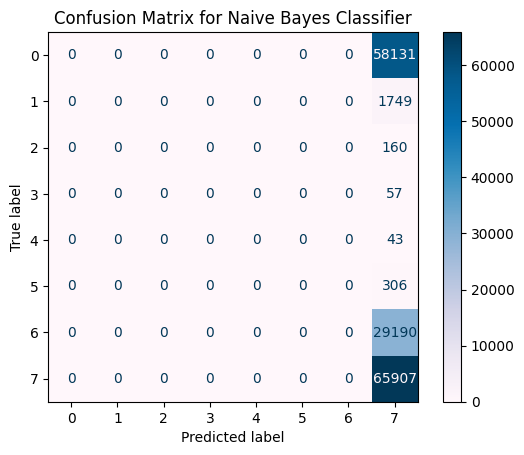
Confusion Matrix for Random Forest Classifier#
# Menghitung confusion matrix
cm_rf = confusion_matrix(Y_test, Y_pred_rf)
# Menampilkan confusion matrix
disp_rf = ConfusionMatrixDisplay(confusion_matrix=cm_rf)
disp_rf.plot(cmap=plt.cm.GnBu)
plt.title("Confusion Matrix for Random Forest Classifier")
plt.show()
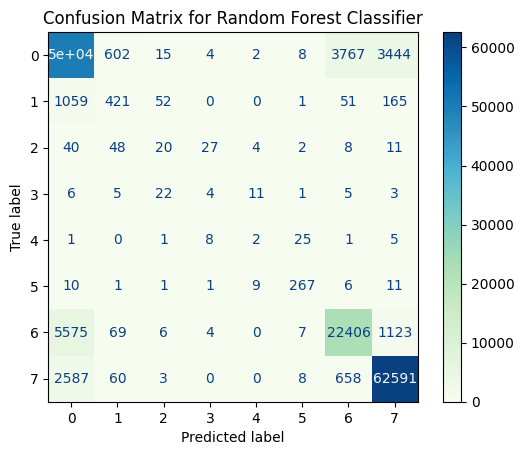
Melihat distribusi data test dan train#
langkah ini di lakukan untuk mencocokan jumlah data pada cinfusion matrix
train_size = len(X_train)
test_size = len(X_test)
plt.figure(figsize=(8, 6))
bars = plt.bar(["Train", "Test"], [train_size, test_size], color=['skyblue', 'lightcoral'])
for bar in bars:
plt.text(bar.get_x() + bar.get_width()/2 - 0.05, bar.get_height() + 100, '%d' % int(bar.get_height()), ha='center', va='bottom', color='black')
plt.title('Train and Test Data Sizes')
plt.ylabel('Number of Samples')
plt.xlabel('Dataset')
plt.show()
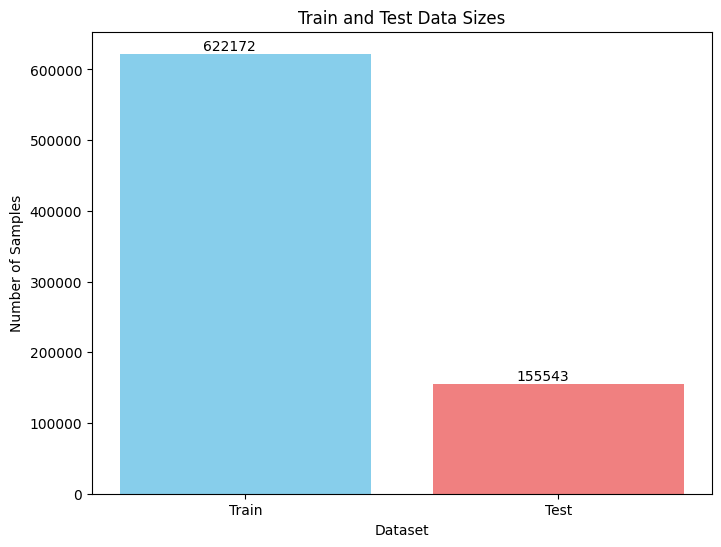
import numpy as np
train_size = len(X_train)
test_size = len(X_test)
unique_classes = np.unique(np.concatenate((Y_train, Y_test), axis=None))
train_class_counts = [np.sum(Y_train == cls) for cls in unique_classes]
test_class_counts = [np.sum(Y_test == cls) for cls in unique_classes]
fig, ax = plt.subplots(figsize=(10, 6))
bar_width = 0.35
index = np.arange(len(unique_classes))
train_bars = ax.bar(index - bar_width/2, train_class_counts, bar_width, label='Train', color='skyblue')
test_bars = ax.bar(index + bar_width/2, test_class_counts, bar_width, label='Test', color='lightcoral')
for bar in train_bars:
plt.text(bar.get_x() + bar.get_width()/2 - 0.2, bar.get_height() + 20, '%d' % int(bar.get_height()), ha='center', va='bottom', color='black')
for bar in test_bars:
plt.text(bar.get_x() + bar.get_width()/2 + 0.2, bar.get_height() + 20, '%d' % int(bar.get_height()), ha='center', va='bottom', color='black')
ax.set_title('Class Distribution in Train and Test Data')
ax.set_xlabel('STATUS')
ax.set_ylabel('Number of Samples')
ax.set_xticks(index)
ax.set_xticklabels(unique_classes)
ax.legend()
plt.tight_layout()
plt.show()

